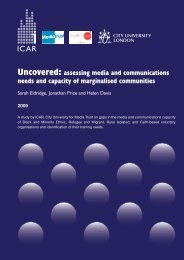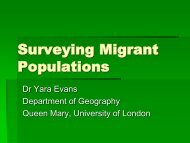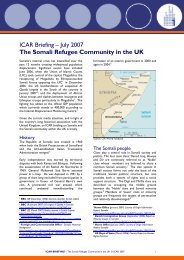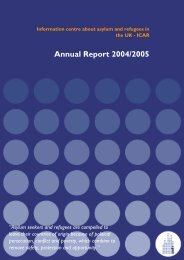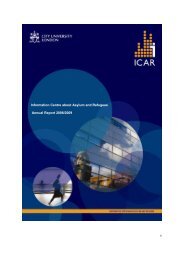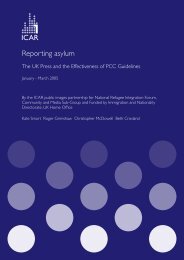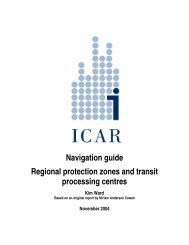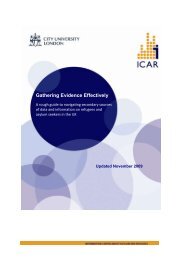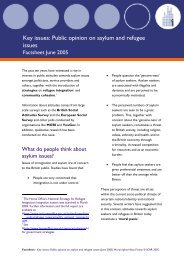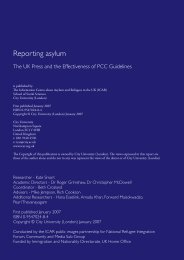Key issues: Resettlement programmes and the UK - ICAR
Key issues: Resettlement programmes and the UK - ICAR
Key issues: Resettlement programmes and the UK - ICAR
Create successful ePaper yourself
Turn your PDF publications into a flip-book with our unique Google optimized e-Paper software.
Third country integration attempts to returnindependence to resettled refugees <strong>and</strong> provide<strong>the</strong>m with <strong>the</strong> capacity to build a positive future in<strong>the</strong> receiving society. Before <strong>the</strong> refugees arrive,<strong>the</strong> host government will co-ordinate withvoluntary <strong>and</strong> refugee organisations to provide <strong>the</strong>necessary services <strong>and</strong> provide <strong>the</strong> public withinformation about <strong>the</strong> new arrivals. They are oftenreceived in designated centres <strong>and</strong> provided withvital information about living in <strong>the</strong>ir new society.Upon leaving reception facilities, resettled refugeesare provided with affordable housing <strong>and</strong> o<strong>the</strong>rvital support to aid <strong>the</strong>ir integration.Legal aspects to resettlementThe resettlement process is not defined in <strong>the</strong>Refugee Convention or in <strong>UK</strong> law, yet espouses<strong>the</strong> intentions of both in terms of protection <strong>and</strong>assistance of refugees. The Nationality,Immigration <strong>and</strong> Asylum Act 2002 provides <strong>the</strong>legal context for resettlement <strong>and</strong> <strong>the</strong> <strong>UK</strong>. Section59 indicates that <strong>the</strong> government may ‘participatein a project which is designed to…arrange orassist <strong>the</strong> settlement of migrants’. 2The Home Office White Paper Secure Borders,Safe Haven: Integration with Diversity (2002) 3announced <strong>the</strong> development of an annualresettlement programme to <strong>the</strong> <strong>UK</strong>, known as <strong>the</strong>Gateway Protection Programme. A number ofrefugees from West Africa <strong>and</strong> South East Asiawere resettled under this programme in <strong>the</strong> <strong>UK</strong> in2004. The programme, operated by bodies within<strong>the</strong> Home Office, initially took most referrals from<strong>the</strong> UNHCR centre in Accra, Ghana <strong>and</strong> aimed toresettle 500 people by April 2004. As <strong>the</strong>programme has developed, <strong>the</strong> Home Office hasbegun to include o<strong>the</strong>r locations where UNHCRis in operation.Home Office caseworkers address eachindividual’s criteria for resettlement based onwhe<strong>the</strong>r <strong>the</strong> applicant’s human rights are at riskin <strong>the</strong> country of refuge or, where <strong>the</strong>re is noimmediate risk, whe<strong>the</strong>r resettlement canprovide a durable solution for long termprotection needs. The applicant is required toco-operate with <strong>UK</strong> officials <strong>and</strong> be committedto supporting himself or herself in <strong>the</strong> <strong>UK</strong>.Useful documentsUNHCR (2004) <strong>Resettlement</strong> H<strong>and</strong>book,2004 edition. Geneva: UNHCR.UNHCR (2004) Integration H<strong>and</strong>book:Refugee <strong>Resettlement</strong>, 2004 edition. Geneva:UNHCRRefugee Council (2002) Principles for a <strong>UK</strong>resettlement programme. London: RefugeeCouncilAn applicant can be turned down if he or she hascommitted a crime against peace, a serious nonpoliticalcrime or has been guilty of acts contraryto <strong>the</strong> aims of <strong>the</strong> UN. Applicants referred by<strong>the</strong> UNHCR <strong>and</strong> <strong>the</strong>n accepted by <strong>the</strong> <strong>UK</strong> arenormally granted indefinite leave to remainallowing <strong>the</strong>m free rights to live, work <strong>and</strong> claimbenefits in <strong>the</strong> <strong>UK</strong> <strong>and</strong> travel abroad o<strong>the</strong>r thanto <strong>the</strong> country <strong>the</strong>y are seeking refugee from.After five years of living in <strong>the</strong> <strong>UK</strong> continuouslyresettled refugees will be able to apply forcitizenship.P 2 P Home Office (2002) Nationality, Immigration<strong>and</strong> Asylum Act. London HMSO.P 3 P Home Office (2002) Secure Borders, SafeHaven: Integration with Diversity. London: HMSO.Factsheet - <strong>Key</strong> <strong>issues</strong>: <strong>Resettlement</strong> <strong>programmes</strong> <strong>and</strong> <strong>the</strong> <strong>UK</strong> (October 2005) © <strong>ICAR</strong> 2005.
What is <strong>the</strong> <strong>UK</strong>’s experience ofresettling refugees?The <strong>UK</strong> has a long history of resettlement, yet ithas largely been on an ad hoc basis. Someexamples include: 4‣ 210,000 Polish Second World War exilescame to <strong>the</strong> <strong>UK</strong> from 1940 to 1950, fleeing<strong>the</strong> Nazi invasion. Their integration wassuccessful as <strong>the</strong>y found both housing <strong>and</strong>employment with relative ease.‣ 42,000 Ug<strong>and</strong>an Asians, expelled from<strong>the</strong>ir country by Idi Amin, were resettled inBritain in 1972-4. The main focus of <strong>the</strong>resettlement strategy was to find <strong>the</strong>Ug<strong>and</strong>ans mainstream housing, though manyfound <strong>the</strong>ir own accommodation throughinformal networks.‣ 22,500 Vietnamese displaced personsarrived in <strong>the</strong> <strong>UK</strong> from 1972. The JointCommittee for Vietnamese Refugees coordinateda number of charities to carry out<strong>the</strong> operational details <strong>and</strong> service provisionfor this programme. An absence of a preexistingethnic community contributed to highunemployment rates <strong>and</strong> significant secondarymigration for this community.There are two o<strong>the</strong>r refugee assistance<strong>programmes</strong> (although <strong>the</strong>y do not constituteformal resettlement <strong>programmes</strong>). The first is <strong>the</strong>‘M<strong>and</strong>ate Refugee Programme’, which allowsindividuals to claim asylum whilst overseas <strong>and</strong> <strong>the</strong>second is <strong>the</strong> ‘ten or more plan’, which assistsrefugees with disabilities or a serious medicalcondition.A service provider’s experienceS<strong>and</strong>y Buchan, Chief Executive of RefugeeAction, ran a residential centre in <strong>the</strong> 1980sfor Vietnamese refugees in Osterley. Ithosted a number of policy experiments:• fast-track education for refugee childrenenabling <strong>the</strong>m to gain ‘O’ levels• social work training to build capacitywithin <strong>the</strong> Vietnamese community• a reception model made up of ‘learningvillages’ <strong>and</strong> high levels of VietnamesestaffingLessons from this programme were used indeveloping <strong>the</strong> strategy for <strong>the</strong> Bosnian <strong>and</strong>Kosovan <strong>programmes</strong>.____From personal interview conducted forEsterhuizen, L (2004) Making better use ofrefugee data <strong>and</strong> information. London: <strong>ICAR</strong>While resettlement is not synonymous with‘temporary protection’, <strong>the</strong> Bosnian EvacuationProgramme <strong>and</strong> <strong>the</strong> Kosovan HumanitarianEvacuation Programme can help underst<strong>and</strong> <strong>the</strong>development of targeted service for groupsevacuated to <strong>the</strong> <strong>UK</strong>. Bosnian refugees weredispersed in ‘clusters’ in order to form ethniccommunities. 5 Similar strategies were used with<strong>the</strong> Kosovan programme <strong>and</strong> both were seen asrelatively successful in integrating <strong>the</strong> refugees in<strong>UK</strong> society. These <strong>programmes</strong> have providedopportunities for learning for future resettlement<strong>programmes</strong>.P 4 P More detail on <strong>the</strong> <strong>UK</strong>’s history of resettlement canbe found in Robinson, V. (2003:3) ‘An evidence basefor future policy: reviewing <strong>UK</strong> resettlement policy’ inGelsthorpe, V. <strong>and</strong> Herlitz, L. (eds) Listening to evidence:<strong>the</strong> future of <strong>UK</strong> resettlement. Conference proceedings.London: Home Office.P 5 P Robinson, V. <strong>and</strong> C. Coleman (2000) ‘Lessonslearned?: a critical review of <strong>the</strong> governmentprogramme to resettle Bosnian quota refugees in <strong>the</strong>United Kingdom’. International Migration Review 34 (4)pp. 1217-1244Factsheet - <strong>Key</strong> <strong>issues</strong>: <strong>Resettlement</strong> <strong>programmes</strong> <strong>and</strong> <strong>the</strong> <strong>UK</strong> (October 2005) © <strong>ICAR</strong> 2005.
Challenges for resettlementThe first phase of resettlement, overseasprocessing, faces a number of obstacles <strong>and</strong>examples include:‣ Interpretation of refugee definitionThere is often a discrepancy between how<strong>the</strong> UNHCR <strong>and</strong> nation-states define arefugee, which means that some refugeesreferred by <strong>the</strong> UNHCR are not accepted bysome states as a refugee.‣ SelectivityThere is a tendency among some states to‘h<strong>and</strong>-pick’ refugees by imposing additionalcriteria for those to be resettled, oftenaccepting people with greater integrationpotential <strong>and</strong> leaving behind refugees atgreater risk.‣ ResourcesUNHCR cares for over seventeen milliondisplaced people. To prepare cases forresettlement is incredibly time-consuming<strong>and</strong> <strong>the</strong> organisation is unable to cope withan exp<strong>and</strong>ing resettlement programme. 6There is a need for states offering increasedresettlement opportunities to provideUNHCR with more funding.The second phase of <strong>the</strong> resettlement process isthird country integration <strong>and</strong> a number of lessonshave been learnt about overcoming obstacles fromprevious <strong>programmes</strong>. Examples include:‣ Front loadingPrevious <strong>programmes</strong> to resettle largenumbers of people in <strong>the</strong> <strong>UK</strong> have beencharacterised by ‘front loading’, whichinvolves focusing on providing all <strong>the</strong>information <strong>and</strong> integration ‘tools’ refugeesP 6 P United States Committee for Refugees (2003)‘UNHCR faces funding cuts.’ Refugee Reports 24 (1)need when <strong>the</strong>y first arrive. This has beenbalanced with a desire for <strong>the</strong> receptionstage to remain short-term to avoidprotracted welfare reliance. Consequently,in <strong>the</strong> past, resettled refugees have sufferedfrom an absence of assistance beyondreception. 7 The structure of <strong>the</strong> Bosnian <strong>and</strong>Kosovan <strong>programmes</strong> learnt from this <strong>and</strong>provided mid-term support teams indispersal areas <strong>and</strong> improved interactionwith mainstream services.‣ Employment readinessA focus on housing provision in manyresettlement <strong>programmes</strong> has made it moredifficult for refugees to find employment.Research suggests that dispersal strategieshave not been based on thorough analysis of<strong>the</strong> local labour market. This is in contrastto o<strong>the</strong>r resettlement countries, whereemployment readiness is placed at <strong>the</strong> coreof refugee independence.‣ Refugee Community Organisations(RCOs)When resettled refugees leave receptionfacilities, RCOs can act as a social buffer <strong>and</strong>information translator in a receivingcommunity. They also offer a bridgebetween <strong>the</strong> refugees’ private <strong>and</strong> publicspheres. In past refugee <strong>programmes</strong> <strong>the</strong>rehave been examples of locating clusters ofresettled populations near to pre-existingethnic communities. There is debate as towhe<strong>the</strong>r this actually fosters communitydevelopment or in fact creates situation ofresource competition between RCOs. 8P 7 P Hale, S. (1993) ‘The reception <strong>and</strong> resettlementof Vietnamese Refugees in Britain.’ In V. Robinson (ed)The international refugee crisis: British <strong>and</strong> Canadianresponses. London: MacmillanP 8 P Kelly, L. (2003) ‘Bosnian refugees in Britain:questioning community’. Sociology 37 (1) pp. 35-49Factsheet - <strong>Key</strong> <strong>issues</strong>: <strong>Resettlement</strong> <strong>programmes</strong> <strong>and</strong> <strong>the</strong> <strong>UK</strong> (October 2005) © <strong>ICAR</strong> 2005.
‣ Increase refugee engagementService provision within resettlement<strong>programmes</strong> has been primarily organised ona top-down basis. Research suggests thatwhen services are delivered as part of anational programme <strong>the</strong>y can sometimes beunresponsive <strong>and</strong> unable to adjust to localneeds. This organisational schema does notappear to engage with refugees <strong>and</strong> <strong>the</strong>irexperiences in <strong>the</strong> process of <strong>the</strong>ir ownintegration. Research on Bosnian refugees inItaly show that resettled refugees can developmeaningful social networks to aid <strong>the</strong>ir ownintegration. 9<strong>Resettlement</strong> Inter-AgencyPartnership (RIAP)A group of NGOs make up <strong>the</strong> RIAP, whichis responsible for service delivery under <strong>the</strong>Gateway programme:• British Red Cross;• International Rescue Committee;• Migrant Helpline;• Refugee Action;• Refugee Arrivals Project;• Refugee Council;• Refugee Housing Association; <strong>and</strong>• Scottish Refugee Council.The Gateway ProtectionProgrammeThis programme has endeavoured to learn from<strong>the</strong> difficulties of previous resettlement<strong>programmes</strong> <strong>and</strong> forms <strong>the</strong> basis futureresettlement policy in <strong>the</strong> <strong>UK</strong>.The Home Office maintains a central co-ordinatingrole in this programme but responsibility for itspractical implementation has been delegated to arange of organisations. Also, criteria for <strong>the</strong> areasto which resettled refugees are dispersed nowinclude more than just <strong>the</strong> availability of housing:local NGO involvement, racial tolerance,employment opportunities <strong>and</strong> <strong>the</strong> presence ofexisting RCOs are some of <strong>the</strong> extra factors takeninto account.P 9 P Korac, M. (2001) HUPresentation at ‘Bridging<strong>the</strong> information gaps: a conference of research onasylum <strong>and</strong> immigration in <strong>the</strong> <strong>UK</strong>’UH, 21 March2001, London. Available atHUhttp://www.homeoffice.gov.uk/rds/pdfs/irssconf21301.pdfUHMany of <strong>the</strong>se agencies have been involvedin previous <strong>programmes</strong> <strong>and</strong> so <strong>the</strong>irinvolvement builds on expertise <strong>and</strong>relationships developed in previousinitiatives.A development of <strong>the</strong> Gateway programme hasbeen for refugees to participate in a four-daycultural orientation programme prior todeparture to <strong>the</strong> <strong>UK</strong>. Also, on arrival refugeesare no longer accommodated in large-scale sitesbut more frequently in hotels near airports,where fur<strong>the</strong>r orientation sessions areprovided. 10Responsibility for settlement <strong>and</strong> support ofrefugees resettled under <strong>the</strong> Gatewayprogramme differs according to <strong>the</strong> areaconcerned, with organisations such as <strong>the</strong>Refugee Council <strong>and</strong> Refugee Action beingresponsible for specific areas. Refugees areP 10 P The four day sessions are run by <strong>the</strong>HUInternational Rescue CommitteeUH; TheHURefugee Arrival Project UH<strong>and</strong> MigrantHelpline organise <strong>the</strong> fur<strong>the</strong>r orientation sessionsFactsheet - <strong>Key</strong> <strong>issues</strong>: <strong>Resettlement</strong> <strong>programmes</strong> <strong>and</strong> <strong>the</strong> <strong>UK</strong> (October 2005) © <strong>ICAR</strong> 2005.
supported by a combination of mainstream welfareprovision <strong>and</strong> individualised settlement plans. Thelevel of provision is more intensive early in <strong>the</strong>resettlement, but is provided for at least <strong>the</strong> firsttwelve months. Housing is provided by <strong>the</strong> localresettlement agency <strong>and</strong> in <strong>the</strong>ir first few weeks,refugees are referred to <strong>the</strong> Job Centre Plus <strong>and</strong>assisted in registering with a GP <strong>and</strong> opening abank account.Initial findings from a Liberian group resettled inSheffield found that after six weeks <strong>the</strong> majority of<strong>the</strong> children were attending school, most adultswere also attending language <strong>and</strong> computercourses, <strong>and</strong> all had been able to access healthservices. 11The Home Office is conducting longitudinalresearch into settlement <strong>and</strong> integrationexperiences of gateway refugees through <strong>the</strong>Immigration Research <strong>and</strong> Statistics Service (IRSS).This consists of regular interviews with resettledrefugees over <strong>the</strong> age of sixteen. It is intended that<strong>the</strong> findings will inform future programmedevelopment <strong>and</strong> wider integration strategies. TheHome Office also intends to carry out apreliminary evaluation of <strong>the</strong> Gateway programmein 2005.<strong>Resettlement</strong> statisticsResettled refugees are not included in <strong>UK</strong> asylumstatistics as <strong>the</strong>y do not go through <strong>the</strong> asylumsystem. Every year, around 310 individuals aretypically admitted under <strong>the</strong> M<strong>and</strong>ate Refugees <strong>and</strong>Ten or More <strong>programmes</strong>. The InternationalOrganization for Migration (IOM) estimates that in2000 <strong>and</strong> 2001 <strong>the</strong> <strong>UK</strong> received 429 <strong>and</strong> 420refugees <strong>and</strong> family members through <strong>the</strong>seP 11 P Home Office (November 2004) Underst<strong>and</strong>ingGateway: <strong>the</strong> Gateway Protection Programme for refugees.London: Home OfficeUNHCR <strong>programmes</strong> <strong>and</strong> o<strong>the</strong>r IOM facilitatedarrangements. 12Examples of international figuresBelow are selected statistics from <strong>the</strong> UNHCR’sbasic programme information. They areindicative of <strong>the</strong> complications involved ininternational comparison.• Australia Quota for July 2003-June 2004was 10,991. At <strong>the</strong> end of January 20044,255 visas for <strong>the</strong>se <strong>programmes</strong> had beengranted. In 2002/2003 11,656 visas for<strong>the</strong>se <strong>programmes</strong> were granted.• Canada Quota for 2003 was 10,400-11,700 (inclusive of government assisted<strong>programmes</strong>) <strong>and</strong> 10,762 refugees wereaccepted in that year.• Finl<strong>and</strong> Quota for 2003 was 750 <strong>and</strong> 748refugees were accepted of which 562 hadarrived in <strong>the</strong> country (yet 482 were from<strong>the</strong> 2002 quota).• New Zeal<strong>and</strong> Quota for July 2003-June2004 was 750 <strong>and</strong> 196 were accepted.• Sweden Quota for 2004 was 1,700 <strong>and</strong> by<strong>the</strong> end of February 2004 300 had beenaccepted of which 35 had arrived.• United States of America Quota forOctober 2003-September 2004 was 50,000(with 20,000reserve places). By endFebruary 2004 14,403 had arrived. In <strong>the</strong>2003 fiscal year 28,455 refugees wereacceptedFrom UNHCR Easy guide on refugee resettlementprograms 2003/2004P 12 P IOM (2003) HU‘Global trends in resettlement:comparing <strong>the</strong> <strong>UK</strong> with o<strong>the</strong>r countries’UH in ’ inGelsthorpe, V. <strong>and</strong> Herlitz, L. (eds) Listening toevidence: <strong>the</strong> future of <strong>UK</strong> resettlement. Conferenceproceedings. London: Home Office. Available athttp://www.homeoffice.gov.uk/rds/pdfs2/resettlement.pdf.Factsheet - <strong>Key</strong> <strong>issues</strong>: <strong>Resettlement</strong> <strong>programmes</strong> <strong>and</strong> <strong>the</strong> <strong>UK</strong> (October 2005) © <strong>ICAR</strong> 2005.
The quota for <strong>the</strong> Gateway Protection Programmeoffered a maximum of 500 places in fiscal years of2003/2004 <strong>and</strong> 2004/2005. At <strong>the</strong> end of June2005, 121 refugees had been settled in Sheffield(Liberian <strong>and</strong> Burmese) <strong>and</strong> 81 refugees had beensettled in Bolton (Congolese <strong>and</strong> Liberian).Making international comparisons of resettlementdata is a difficult task. Each resettlement countryoperates a number of different schemes, somethrough <strong>the</strong> UNHCR, some autonomously. As aresult, a number of organisations collectresettlement data but it is difficult to aggregate asdifferent countries use different procedures tocollect <strong>the</strong> data. For example some countriescollect data across <strong>the</strong> fiscal year <strong>and</strong> o<strong>the</strong>rsacross <strong>the</strong> calendar year. Also, some countriesfocus on <strong>the</strong>ir annual quotas ra<strong>the</strong>r than <strong>the</strong> actualnumber of arrivals.ResourcesA full discussion of <strong>the</strong>se <strong>issues</strong> <strong>and</strong> concepts isprovided in <strong>ICAR</strong>’s Navigation guide toresettlement <strong>and</strong> <strong>the</strong> <strong>UK</strong> available at:www.icar.org.uk/navigationguidesThe navigation guide includes a full list ofresources <strong>and</strong> projects. Some examples ofadditional resources to those already listed orhighlighted elsewhere in <strong>the</strong> Factsheet are givenbelow.Gelsthorpe, V. <strong>and</strong> Herlitz, L. (eds) (2003)Listening to evidence: <strong>the</strong> future of <strong>UK</strong> resettlement.Conference proceedings. London: Home Office.Home Office (November 2004) Underst<strong>and</strong>ingGateway: <strong>the</strong> Gateway Protection Programme forrefugees. London: Home Office.Kerrigan, S. (2003) 'Resettling Refugees' InExile,issue 28, November 2003.Refugee Council (July 2004) The GatewayProtection Programme: Refugee <strong>Resettlement</strong> in <strong>the</strong><strong>UK</strong>T. London: Refugee Council.<strong>Resettlement</strong> Inter-Agency Partnership(RIAP) (October 2004) Welcome to <strong>the</strong> <strong>UK</strong> - Afirst step. London: Refugee Council.Robinson, V. (1999) 'The evolution of refugeeresettlement policy in post-war Britain', in V.Robinson (ed.) Migration <strong>and</strong> Public Policy.Cheltenham: Edward Elgar.Robinson, V. <strong>and</strong> C. Coleman (2000)'Lessons learned? A critical review of <strong>the</strong>government programme to resettle Bosnianquota refugees in <strong>the</strong> United Kingdom'.International Migration Review 34 (4) pp.1217-1244.Spack. T. (2001) ‘Global Overview: refugeeresettlement <strong>and</strong> integration models <strong>and</strong>methods’, from <strong>the</strong> International Conference on<strong>the</strong> Reception <strong>and</strong> Integration of ResettledRefugees, Sweden.Hale, S. (1993) 'The reception <strong>and</strong> resettlementof Vietnamese Refugees in Britain.' In V. Robinson(ed) The international refugee crisis: British <strong>and</strong>Canadian responses. London: Macmillan.Author of factsheet: Gareth MorrellFactsheet - <strong>Key</strong> <strong>issues</strong>: <strong>Resettlement</strong> <strong>programmes</strong> <strong>and</strong> <strong>the</strong> <strong>UK</strong> (October 2005) © <strong>ICAR</strong> 2005.




